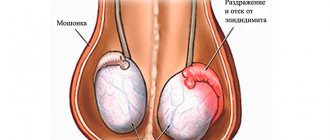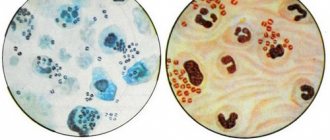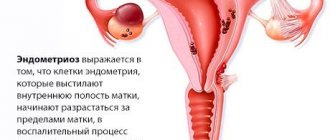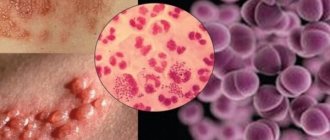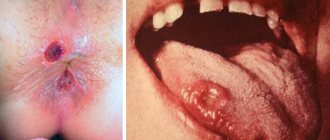What is nonspecific urethritis in men
Nonspecific urethritis (nongonorrheal, nongonococcal urethritis) is an inflammation of the urethra, provoked by any reason other than specific infections. The latter include: gonorrhea, syphilis, tuberculosis.
Causes and classification
Depending on the cause of occurrence, infectious and non-infectious urethritis are distinguished . In the first case, the pathogens are Escherichia coli, staphylococcus, enterococcus, streptococcus, Proteus, Klebsiella, and adenoviruses. Some of them belong to opportunistic microflora, that is, they are asymptomatically present in the body in small quantities.
Factors provoking the development of infectious nonspecific urethritis:
- Having anal and oral sex without a condom.
- Unprotected sex with a woman suffering from nonspecific inflammation of the genital organs.
- Poor intimate hygiene, narrowing of the foreskin (phimosis).
- Catheterization.
- Chronic prostatitis and other infectious foci.
In non-infectious urethritis, inflammation is provoked by injuries, mechanical damage to the urethra and its strictures (pathological narrowings), allergies, and tumors.
Urethral stricture is a pathological narrowing of the internal lumen of the urethra, leading to urination disorders of varying severity.
Factors predisposing to the development of non-infectious nonspecific urethritis:
- Decreased immunity (fundamental factor).
- Urolithiasis disease.
- Metabolic disorders. For example, crystalluria, in which a large amount of salts is excreted in the urine. They injure the walls of the urethra, causing inflammation.
- Stagnation of blood and lymph in the pelvic area (congestion), against the background of which nonspecific bacterial flora actively multiplies.
- Intestinal diseases (hemorrhoids, chronic constipation).
Nonspecific non-infectious urethritis can also develop due to microflora disturbances and immune suppression due to long-term use of antibiotics, immunosuppressants, and hormones. The non-infectious form often becomes infectious due to the addition of bacteria.
Sergey Gennadievich Lenkin, urologist, dermatovenerologist, learn more about the types and causes of the development of nonspecific urethritis in men
Depending on the origin of the pathogen, infectious nonspecific urethritis can be of two types:
- Primary, when the pathogen enters the urethra from the outside (from the mouth, rectum, from the hands) and multiplies in it.
- Secondary, in which the infection enters the urethra from other organs through the flow of lymph or blood.
According to the nature of its course, nonspecific urethritis can be acute or chronic. In the second case, the periodic appearance of vague symptoms is characteristic. The main catalyst for exacerbations is hypothermia, intense sex, frequent masturbation, and alcohol intake.
Main symptoms of the disease
Signs of the development of the disease can be very diverse. The clinical picture of the disease is represented by acute and chronic forms.
The acute form manifests itself when the incubation period passes from the moment the pathogen enters.
The following sensations arise:
- the appearance of sharp pain at the time of urination;
- the occurrence of burning and itching at the exit of the urethra;
- the appearance of discharge with a mucous or purulent structure;
- bad smell.
In case of allergies, in parallel with the above symptoms, the following are observed:
- difficulty breathing associated with nasal congestion;
- rash on the skin;
- lacrimation;
- the appearance of shortness of breath.
Upon examination, the urologist may detect a low degree of swelling of the mucous membrane, redness of all tissues that surround the urethra.
Symptoms of nonspecific urethritis
Signs of acute nonspecific inflammation of the urethra:
- Constant burning and aching in the urethra, increasing during urination.
- Discharge from the urethra. When bacteria attach, they can acquire a gray, greenish, or yellow tint.
- When you feel the urethra through the penis, you feel its thickening and pain.
- Flakes, threads, streaks of blood in the first portion of urine. Their appearance is due to the fact that inflammation damages the walls of the urethra, epithelial particles intensively exfoliate (flaking off), and bleeding ulcerations appear.
- If the posterior part of the urethra is affected, the number of urinations sharply increases. At the end, a sharp pain is felt, and blood may be released.
The urethral sponges (meatus) turn red, swell, stick together, and yellowish crusts form on them. Urination is difficult. In an acute inflammatory process, signs of intoxication may appear: headache, fever.
Dermatovenerologist Sergey Gennadievich Lenkin talks about the symptoms and treatment of nonspecific inflammation of the urethra after slight hypothermia and drinking alcohol.
Symptoms of chronic urethritis:
- Mild discomfort, itching in the urethra;
- There are almost no discharges;
- The urethral sponges may sometimes stick together;
- The first portion of urine is transparent, but small mucous threads are visible in it, settling to the bottom.
In many men, chronic nonspecific urethritis is accompanied by a deterioration in the emotional background and the development of neuroses.
Features of microflora
At the moment of birth of a person, his microflora is formed. Germs and microorganisms get inside, where they create a certain environment. From birth, it is formed from bifidobacteria and lactobacilli, and as the girl grows up, the formation of coccal flora gradually occurs.
In men, the flora does not change from birth; it contains staphylococci, streptococci and corynebacteria. A neutral alkaline environment is formed in the urethra, this is important during the formation of sperm. An important component for the flora of the male body is the presence of the following bacteria:
- commensal;
- rod-shaped bacteria;
- ureaplasma;
- neisseria.
When the flora of the urethra changes, men may develop pathological complications that affect their ability to bear children. Other bacteria are transmitted sexually.
Diagnostics
Diagnosis of nonspecific urethritis is carried out by a urologist and andrologist, but it is better to consult a qualified venereologist. The doctor needs to find out two things: how widespread the inflammatory process is (whether the prostate or bladder is affected) and what is the cause of the inflammation.
First of all, they take a smear from the urethra, urine and blood tests. If gram-negative intracellular diplococci are detected, specific gonococcal urethritis is diagnosed. In their absence and the presence of inflammation, the diagnosis sounds like “nonspecific nongonococcal urethritis.”
Research methods:
- Bacterioscopic (Gram staining of a urethral smear and examination under a microscope) to identify protozoa, microbes, and cellular elements.
- Clinical (multi-glass urine samples, urethroscopy) to assess the degree of damage to the urethra and identify complications in the form of vesiculitis, prostatitis, littreitis (inflamed paraurethral glands). During urethroscopy, condylomas, infiltrates, fibrous areas, and polyps can be detected.
- Bacteriological (inoculation of biomaterial on nutrient media) to determine the type of pathogen.
If necessary, ultrasound of the prostate and bladder and urethrography are prescribed.
Detection of urethritis
The distinctive signs of urethritis are very diverse. The appearance of the first symptoms of the disease depends on the type of pathogenic microorganism and the nature of the inflammation; the duration of the incubation period varies widely - from one hour to several months. It is especially short (no more than one to three hours) for allergic inflammation of the urethra.
It is always necessary to separate specific urethritis from nonspecific and other unnatural processes in the urethra (stones and tumors of the urethra, abnormal growth of tissue over the mucous membrane of the urethra).
If the first signs of the disease appear, you must immediately contact a urologist who will help diagnose and treat the disease. Women also need to visit a gynecologist.
Excluding the main manifestations, a conclusion about the presence of urethritis is made on the basis of a history of sexual intercourse, microscopic analysis of discharge from the urethra (and, if necessary, from the oropharynx and rectum). In addition to microbes and protozoa, leukocytes, mucus and epithelium can be detected. Analysis of a smear from the urethra helps to clarify the set of processes that determine the occurrence, course and outcome of the disease. Under any circumstances, it is necessary to carry out a bacteriological analysis, which includes inoculating the material on a specially designed nutrient medium.
Nowadays, PIF and PCR reactions are widely used in the diagnosis of inflammation of the urinary canal:
- PCR reaction (polymerase chain reaction) is a reaction that allows you to determine microsections of DNA or RNA of foreign genetic material. With the help of analysis, it is possible to recognize the individual characteristics of a particular type of pathogen without confusing it with any other.
- PIF reaction is a direct immunofluorescence reaction. Diagnostics using the PIF method allows you to detect antibodies to a specific pathogen microorganism using a fluorescent (luminous) dye.
The following also help to establish a diagnosis:
- Two- or three-glass urine samples (2 or 3 portions of urine obtained from one urination). If leukocytes or bacteria are detected only in the first portion of urine, it is highly likely that we can talk about urethritis. The glass sample method is especially important for determining the localization of the inflammation process and clarifying the extent of its spread.
- Urethroscopy. During urethroscopy, the urethra (urethra) is examined using an optical device - a urethroscope. A limitation in the study is the acute stage of the disease, but the method is very informative in the torpid and chronic stages.
Urethroscopy can be performed on an outpatient basis or in a hospital setting using local anesthesia
Treatment of nonspecific urethritis in men
Treatment methods for nonspecific urethritis are divided into medicinal, surgical and physiotherapeutic. The treatment regimen is determined by the diagnostic results.
Drugs
For infectious urethritis, antibiotics are prescribed (based on the results of a sensitivity test). Below are international recommendations for the selection of antimicrobial agents for the treatment of non-gonococcal urethritis. During treatment (1-2 weeks), it is necessary to exclude alcohol, sex, hot and spicy foods.
Russian recommendations
Drugs for the treatment of recurrent nongonococcal urethritis (NGU)
Antibacterial treatment may not be effective enough without nonspecific immunotherapy. Prescribe methyluracil 0.5 g three times a day, pentoxyl 0.2 g 4 times a day for a course of 1-2 weeks. Alternatively: pyrogenal or prodigiosan 0.05 mcg in a course of 3-4 injections with an interval of 3-4 days.
For mycotic urethritis, nystatin and levorin are prescribed. Mushroom threads are surrounded by mucus, so drugs in tablet form are not always effective. A guaranteed result is obtained by infusion (instillation) of drugs into the urethra in combination with sodium bicarbonate.
To relieve pain, inflammation and swelling, non-steroidal anti-inflammatory drugs are prescribed: Nurofen, Ketorol.
Herbal medicines that have a diuretic, regenerative and antiseptic effect are prescribed as auxiliary therapy: “Canephron”, “Fitolysin”.
For chronic inflammation, local therapy is effective: infusion into the urethra of a solution of furatsilin, silver nitrate, protargol, 1% solution of dioxidine, hydrocortisone.
Surgical methods
Surgical methods are used to dissect the phimosis ring, urethral strictures, remove tumors and other neoplasms. For inflammation of the paraurethral glands, electrocoagulation is used in some cases. The same method is used to remove genital warts.
Folk remedies
Among the folk remedies for urethritis, infusions of horsetail, knotweed, peppermint, chamomile, and parsley help well. Standard recipe: pour a tablespoon of raw material into 0.5 liters of boiling water, leave in a thermos for an hour. Drink 1/3 glass half an hour before meals. Decoctions relieve spasms, create an environment unfavorable for bacteria, and reduce inflammation.
A classic folk remedy for urinary tract diseases is cranberry and lingonberry. Recipe for lingonberry leaf decoction: pour a tablespoon of raw material into 250 ml of boiling water, leave in a sealed container for 1.5 hours, strain. Drink 2 tablespoons 4 times a day.
A decoction of lingonberry leaves has an anti-inflammatory effect
Pathological anatomy
Among urethral cancers in men, due to the characteristics of their growth, two types are distinguished:
1) nodular cancer, in which a neoplasm in the form of a polyp or cauliflower protrudes into the lumen of the canal, often clogging it;
2) infiltrating cancer with a characteristic compaction of the canal wall, but which does not narrow its lumen for a long time.
Both of these types of cancer exhibit marked rapid growth. The neoplasm spreads throughout the cavernous body of the urethra and, forming hardenings and infiltrates in it, often affects the head of the penis. In other cases, cancer can spread along the surface of the mucous membrane of the urethra. In the subsequent course, cancer, sometimes even in an early stage, can grow through the external opening of the canal to the head of the penis, or spread through the mucous membrane of the urethra to the mucous membrane of the bladder or prostate gland.
While the peripheral parts of the tumor continue to grow rapidly, its central part quickly undergoes decay. As a result of this breakdown, urine penetrates relatively early into the infiltrated submucosal tissue and the cancerous corpus cavernosum of the urethra. As a result, periurethral abscesses and widespread phlegmons form in the area of the infiltrating tumor.
With infiltrating canal cancer, due to urinary infiltration, which accelerates tissue decay, cavities are formed filled with necrotic masses.
Ultimately, the cancer spreads through the tunica albuginea of the corpus cavernosum of the urethra to surrounding tissues; it grows not only the entire genital organ, but often the scrotum, perineum and pelvic tissue.
Continued urinary infiltration and phlegmonous disintegration of this common tumor lead to far-reaching destruction of the external genitalia. Due to infection, there are frequent cases of thrombosis of the pelvic veins, not excluding the external iliac vein.
The vast majority of urethral cancers are histologically squamous cell cancers (90%), and cylindrical, glandular cancers are much less common.
The predominance of squamous cell carcinoma over other types of cancer of the urethra, the mucosa of which is mainly covered with columnar epithelium, can be explained by the often observed metaplasia of the urethral columnar epithelium into squamous cell epithelium. There are also frequent cases of the formation of leukoplakia in the mucous membrane of the urinary canal as a result of various types of inflammatory processes. In addition, in the mucous membrane of the normal urethra, next to the cylindrical epithelium, you can always find separate areas of squamous epithelium.
Metastases of urethral cancer in the early period are often observed in the inguinal and epigastric lymph nodes; later they appear in the mesenteric nodes, often ending in the spread of cancer throughout the abdominal cavity.
In addition to the lymph nodes, urethral cancer sometimes metastasizes to the lungs, pleura and liver.
Complications
The main complications of urethritis:
- Migration of infection to other organs of the genitourinary system, resulting in the development of cystitis, prostatitis, pyelonephritis, inflammation of the testicles, and infertility.
- Inflammatory melting and subsequent narrowing of the urethra, difficulty urinating.
- The transition of inflammation to the cavernous bodies of the penis, their paraurethral scarring and curvature of the organ during erection.
- Impaired potency due to pain in the penis during erection and ejaculation.
If left untreated, acute urethritis will become chronic.
Ways to prevent the disease
It will take a lot of time and effort. It is also important to say that this disease brings very unpleasant painful sensations. In order to avoid this, you need to take preventative measures. In the process of prevention, all possible sources of pathogen entry into the body are completely eliminated. Thus:
- It is important to pay attention to the health of your sexual partner and avoid unprotected sexual contact.
- It is necessary to strictly observe all the rules of personal hygiene, constantly wash yourself using light disinfectants.
- You should not use hygiene products containing alcohol, soap, or components that cause severe irritation of the urethra.
- Eliminate from the diet all foods that lead to irritation of the urinary organs. These products include smoked meats, spicy and salty dishes.
- You should dress warmly (according to the weather) to prevent hypothermia of the body, especially the legs. It is necessary to wear clothes that do not restrict the waist and abdomen, as this leads to slow blood circulation in the pelvic area.
- All emerging diseases should be treated with the utmost seriousness and treated promptly to prevent them from becoming chronic.
Despite the fact that a disease such as urethritis is not considered a fatal disease, it can greatly affect a woman’s health, seriously compromising it. Constant discomfort associated with itching and pain causes severe irritability, insomnia, and negatively affects ability to work. It is better to do everything in a timely manner to prevent the disease than to experience all the negativity of urethritis and treat it for a long time. When the first signs of the disease appear, you should seek help from a specialist as soon as possible.
The urethra (urethra) is an elastic tube responsible for removing urine from the bladder to the outside. In women it is much shorter and wider than in men (3–4 cm long and 1.5 cm wide versus 16–22 cm and 8 mm, respectively). The internal opening of the urethra extends from the bladder, and the canal, passing through the urogenital diaphragm, ends in the vestibule of the vagina with the external opening of the urethra. The hole has a round shape. It is surrounded by hard, roll-like edges. The urethra fuses with the anterior wall of the vagina and runs parallel to it. At the external entrance, the opening of the urethra is narrowed, and at the internal entrance it is widened and has a funnel shape.
Around the canal there is connective tissue, the density of which varies (in the lower sections it is the densest). The wall of the urethra itself consists of muscle and mucous membrane. The muscularis propria consists of an outer, circular layer of smooth muscle and elastic fibers. The mucous membrane is covered with epithelium, which has several layers.
The condition of the urethra can be assessed by a gynecologist during an examination.
Diseases of the urethra in women
The most common disease of the urethra in women is urethritis (inflammation of the urethra). It manifests itself as burning, stinging and pain in the urethra during urination or without any connection with it.
The disease can affect any woman if she is exposed to a number of dangerous factors. Among them, one should especially highlight hypothermia, sexual hyperactivity leading to microtrauma of the urethra, unhealthy diet (excessive consumption of spicy, sour, fried foods and alcohol), disorders of the vaginal microflora and gynecological diseases, kidney diseases (urolithiasis), weak immunity, mechanical damage during medical procedures (catheterization, smear), pathogenic effects of toxic agents and radiation factors.
Female urethritis develops, starting with temporary exacerbations of the disease. Manifestations can vary in strength - from mild discomfort to severe cutting pain. Usually, quite a lot of time passes between exacerbations, and women are in no hurry to see a doctor. But this is a huge mistake, because after a while the pain and burning sensation will come more often, and the effect of antibiotics will become less effective. The most severe stage of female urethritis is constant pain in the urethra.
What causes this unpleasant and dangerous disease? Most often these are some gynecological diseases associated with a violation of the vaginal microflora. This disorder (dysbiosis) can be caused by sexually transmitted infections, among which the most common are chlamydia, trichomoniasis, ureaplasmosis, etc. But, in addition to them, the disease can also develop under the influence of streptococci and other bacteria.
Urethritis can lead to various complications: when inflammation spreads to the bladder, cystitis develops, and if the infection goes further, it can also affect the kidneys, causing pyelonephritis. Chronic urethritis often causes deformation of the urethra, which prevents the normal excretion of urine.
Treatment of the urethra in women
Treatment of inflammation of the urethra in women involves therapy to restore the properties of the urethral wall, normal vaginal microflora and strengthening the immune system. For this purpose, antibiotics, immunomodulators, etc. are used.
Urethritis is quite difficult to treat, but preventive measures to help prevent this disease are quite simple. It is necessary to avoid severe hypothermia, dress according to the weather, observe the rules of intimate hygiene and use contraceptives. It is also important to eat properly and on time, to prevent constipation in every possible way and to avoid stress.
Expert editor: Mochalov Pavel Alexandrovich | Doctor of Medical Sciences general practitioner
Education: Moscow Medical Institute named after. I. M. Sechenov, specialty - “General Medicine” in 1991, in 1993 “Occupational diseases”, in 1996 “Therapy”.
The urethra in men is much smaller than in women. But this is the same urethra, although it has significant differences in structure between the sexes. There are features in the diagnosis of this organ, for example.
The female urethra is a straight tube, similar to the membranous part of the male urethra, but much wider and shorter. Its length varies from 3 to 5 cm. The urethra is located, starting from the neck of the bladder (internal opening), then runs parallel to the vagina, and ends between the entrance to the vagina and the clitoris (external opening). The end of the urethra in a woman has the shape of a slit-like star, with a diameter of 0.3 to 0.6 mm. Most often the form is closed. The entire urethral tube has the same fixed diameter along its entire length. It is equal to from 1 to 1.6 mm.
Due to the fact that the female urethra is very short, bacteria quite often enter the genitourinary system itself higher up. That is why in women, inflammatory processes of the urinary system are observed several times more often than in men. Because of this, women are susceptible to inflammation, kidney and bladder dysfunction.
The urethra has an opening that helps empty the bladder. The female urethra is not involved in reproductive activity; this is the main difference from the male urethra.
After childbirth and in old age, one of the functions of the urethra - holding urine in the bladder - loses its properties, which affects the condition and sensations of the patient. This is a reason to visit a doctor, since it is impossible to return the former functions on your own.
In the female body, the urethra has nothing to do with the reproductive system, but is different from the male
Relapses
Relapses of nonspecific urethritis occur in the following cases:
- Weakening of the immune system.
- Unprotected sex with an infected woman.
- Repeated infection in the urethra from a source of chronic inflammation in the body (tonsillitis, prostatitis).
- Reproduction of an untreated infection.
- The presence of a constant irritant: diabetes mellitus, urolithiasis, herpes virus.
If symptoms reappear, you should consult a doctor again, since the causative agent may already be different.
Treatment
In severe cases of the disease, urethral resection is performed.
At the present stage, medical science knows several options for treating urethral strictures. These include:
- observation;
- bougienage;
- internal optical urethrotomy;
- resection of the urethra with the formation of an anastomosis;
- replacement urethroplasty.
Patients with no or few complaints, normal urinary tract conditions and a small amount of residual urine in the bladder can be under medical supervision. In this case, an annual examination is required. Such patients should be aware of the possible risks of disease progression and the need for active treatment in the future.
Urethral dilation is one of the oldest methods of palliative treatment. The purpose of such an intervention is to expand the stricture to a normal diameter (for this section of the urethra). To do this, a bougie of a certain size is inserted into the urethra after local anesthesia and left for 15-20 minutes. This procedure is repeated periodically. The frequency of its implementation is determined by the doctor, focusing on urination parameters.
Internal optical urethrotomy is equivalent in effectiveness to bougienage. It is used for short traumatic strictures of the spongy urethra. Its essence is to dissect the scar in the narrowing zone. It ensures dilation of the urethra if epithelization precedes excessive growth of scar tissue, which does not always happen. After the intervention, a 3-6 month bougienage or autocatheterization is recommended. Most patients have progression of the pathological process after surgery and require open surgery.
Resection of the urethra with terminal anastomosis is an effective radical method of treating traumatic strictures of the membranous and spongy part of the urethra. However, when the urethra is affected by spongiofibrosis, such intervention is accompanied by frequent relapses of the pathological process. This can be avoided by using anastomotic urethroplasty.
Replacement urethroplasty is one of the most complex surgical interventions on the urethra. It is used for urethral strictures longer than 2 cm, as well as in cases where other methods are not effective. The choice of reconstructive surgery technique depends on the location and length of the narrowing, as well as the presence of complications.
Prevention
Measures to prevent bacterial nonspecific urethritis:
- Use of barrier contraception for any type of intimate contact.
- Timely treatment of inflammatory foci in the body.
- Increasing immunity, healthy lifestyle.
- Prevention of prostatitis.
A balanced diet and monitoring the acidity of urine to prevent the formation of salt deposits and stones will help to avoid the development of nonspecific urethritis. If you have diabetes, it is important to maintain normal blood glucose levels. You should also pay attention to regular bowel cleansing and perform daily exercises to improve blood circulation in the pelvic area to avoid stagnation.
We provide examples of such exercises in the article “Symptoms of blood stagnation in the pelvis in men and methods of its treatment.”


